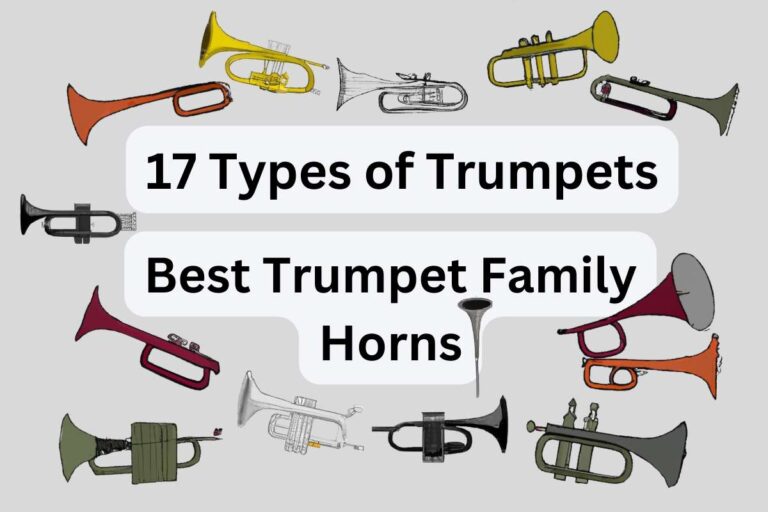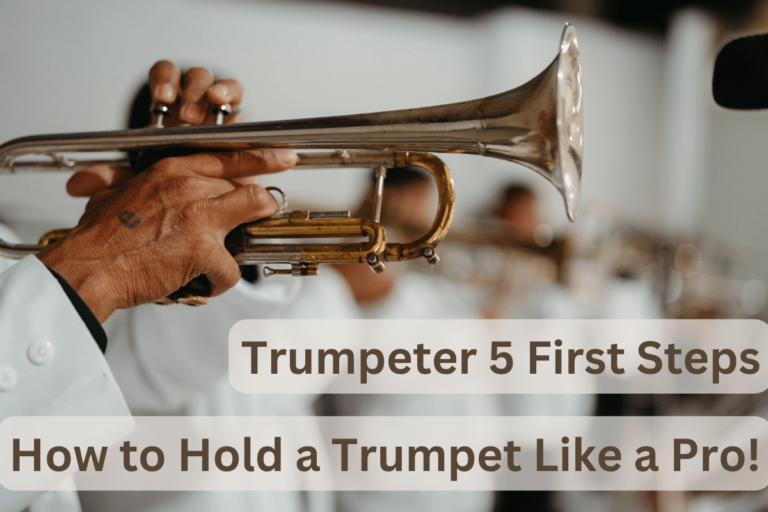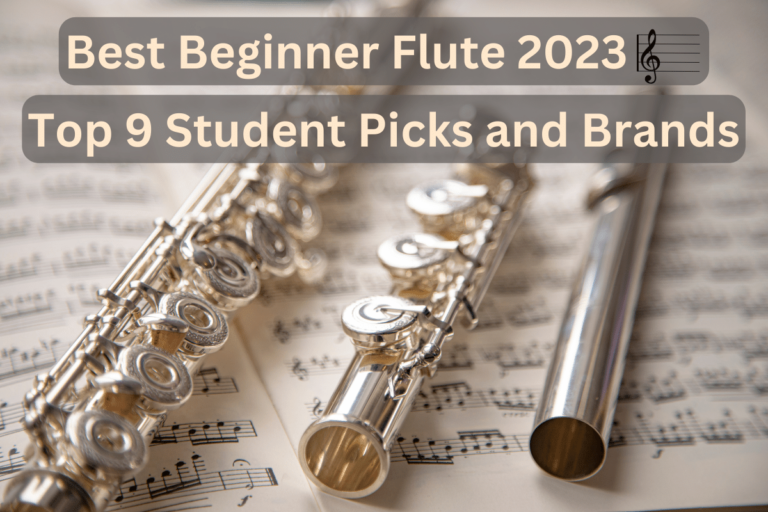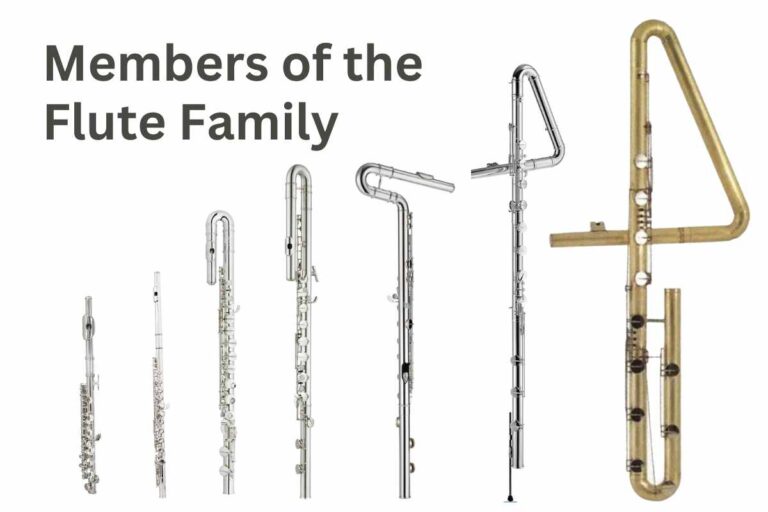13 Different Types of Trombones: From Top to Unpopular 🎺

Welcome to our post covering different types of trombones — and what makes each unique! Ranging from a classic tenor trombone to more unusual models, our guide can help you choose which trombone best matches you! From standard models like the classic tenor trombone to less known historical models, you should understand which trombone fits you by the time you finish reading!
Let’s get reading now and discover some distinctions among them and which type best matches up with you – let’s dive right in!
How Many Different Types of Trombones Are There?
Trombones, made out of brass, have been around since ancient times. Over time they’ve become extremely popular instruments within bands, orchestras and trombone choirs alike for their range of tones and sound quality.
Trombones are diverse when it comes to sound production, size and note range; each type offers various possibilities and notes; six common types exist – tenor, valve, bass, alto, contrabass and soprano with their individual capabilities and traits.
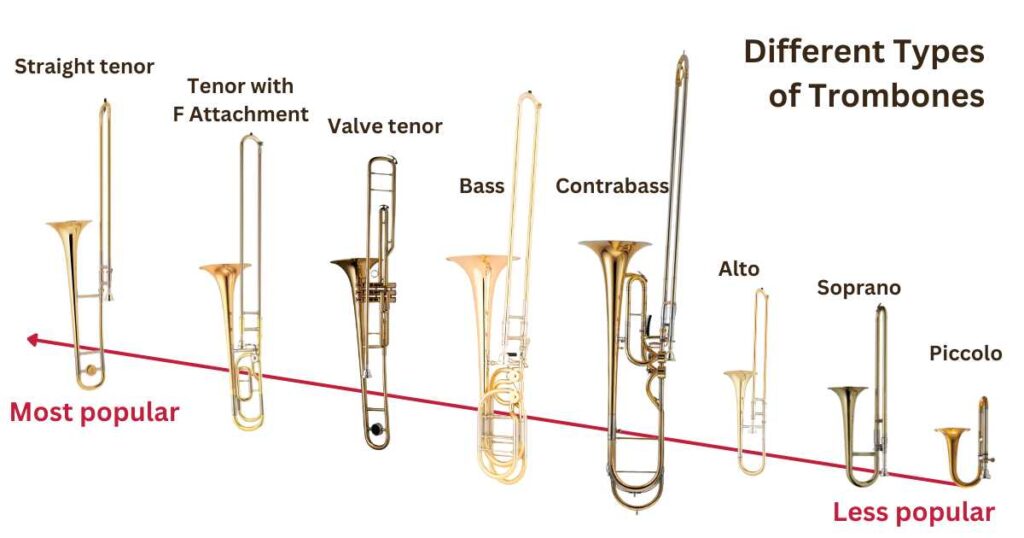
These trombones come in various models such as tenor with F attachment or Bb straight trombones; single or double rotor bass models; as well as variations on bell size, bore size, weight, and configuration of slides.
As a slide trombone player, it’s important that you understand all of the differences among various trombone types. Each has specific qualities to keep in mind when choosing an instrument; knowing this information will enable you to select one that fits your specific needs and preferences best.
Standard Straight Tenor Trombone
Straight standard Bb tenor trombone is one of the most widely played models, distinguished by its lightweight nature and bright, focused sound with excellent intonation. Typically made out of brass material with a slide and bell section (typical bore size:.460″-.525″).
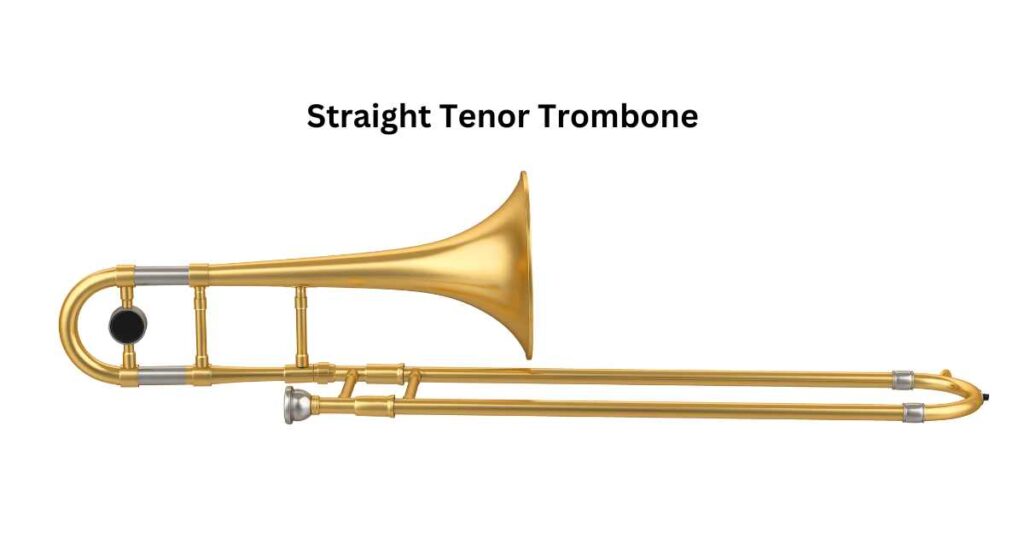
This kind of trombone is the most user-friendly — only two bends allow it to blow smoothly and effortlessly. Furthermore, its simple structure doesn’t contain tubing within its main section allowing an easy playing experience without more complex tubing in each section.
A trombone is played when its slides are moved back and forth over its neck, using either bass-clef notes or even some forms of treble-clef music. Most are pitched at Bb and found throughout many genres of music.
Check out this excellent tenor trombone audition to gain more of an understanding of straight tenor trombones:
The Bb tenor trombone is ideal for jazz soloists as its quick playing of multiple notes lets them quickly create beautiful melodies. However, classical orchestras also use it regularly and sound great together! However, arm length may be required in order to reach the 7th position — typically won’t pose much difficulty to teenagers or adults!
Are you learning how to play trombone? These lightweight trombones make an excellent starting point. Their easy-to-handle controls produce a solid tone that works across various music genres — perfect for beginner musicians! Additionally, these models represent excellent value.
Tenor trombone With F Attachment
This trombone usually boasts a larger bore and bell than regular Bb trombones — requiring additional airflow in order for you to create full sounding notes. What sets it apart, though, is an extra 3 feet of tubing (complete with valve) around its bell section for louder and richer tones. This allows the trombone with F Attachment to play lower keys and shift its pitch from B flat to F.

The F attachment on a trombone can be activated with a trigger to open a valve and access extra tubing, providing alternate positions of notes when activated with the trigger, although effective positions for slide are reduced from 7 to 6. Its valve section is set for F — playing one note with the 1st position rotor engaged (slide in) will produce what sounds like F in the 6th position.
Here you’ll find a short demonstration of a Tenor Trombone equipped with F Attachment:
Extra tubing usually comes in one of two configurations, open wrap or closed wrap; both maintain an equal length of tube length. An open wrap offers more open tones with less resistance needed to produce sound; playing becomes simpler due to the reduced effort needed to produce sounds. Due to additional manufacturing required — these trombones may be slightly pricier.
Valve Trombone
Valve trombones resemble regular trombones but differ by including three valves similar to trumpet or euphonium instruments. Instead of using slides for pitch adjustment, these valves facilitate faster music pieces when necessary — an invaluable asset in playing complex or challenging pieces with ease!
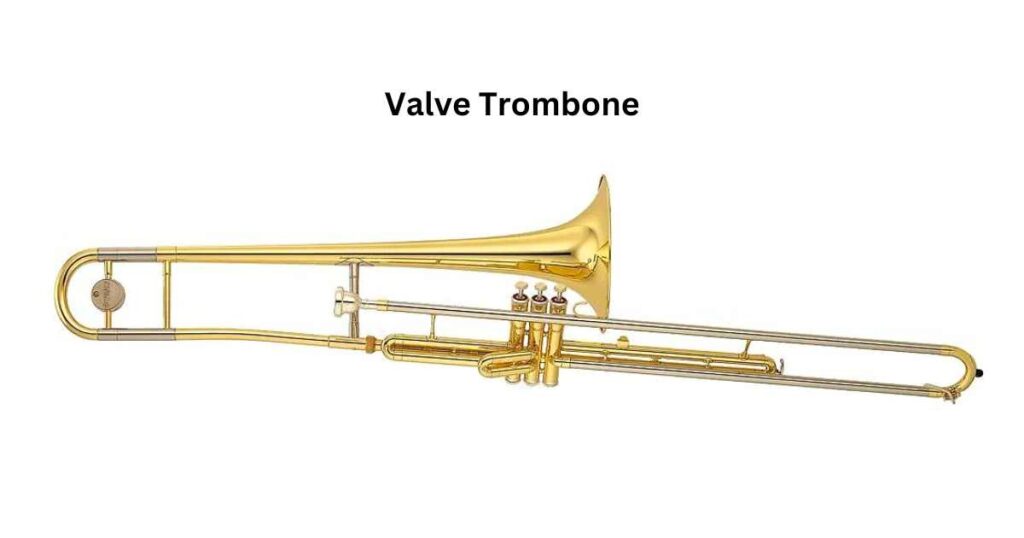
Valve trombones (commonly referred to as piston trombones) were first created during the 1830s. As opposed to regular slide trombones, their valves can be attached to various lengths of tubing for easier playing while offering more complex notes than their traditional slide counterpart. Although easier for most musicians to play than slide trombones, valve trombones often produce stuffier tones — so most pieces prefer slide instruments.
From alto to contrabass sizes, every size of trombone features valve versions; though more often, a valve trombone will be found in tenor voices. Here is a video with a valve trombone demonstration:
Bass Trombone
The bass trombone is like the older sibling to the tenor trombone with F attachment — larger in size with a 9.5″-11″ bell and wider bore size that produce its deep and dark tone. Though capable of hitting low and high notes, its use lies between tenor and contrabass ranges.
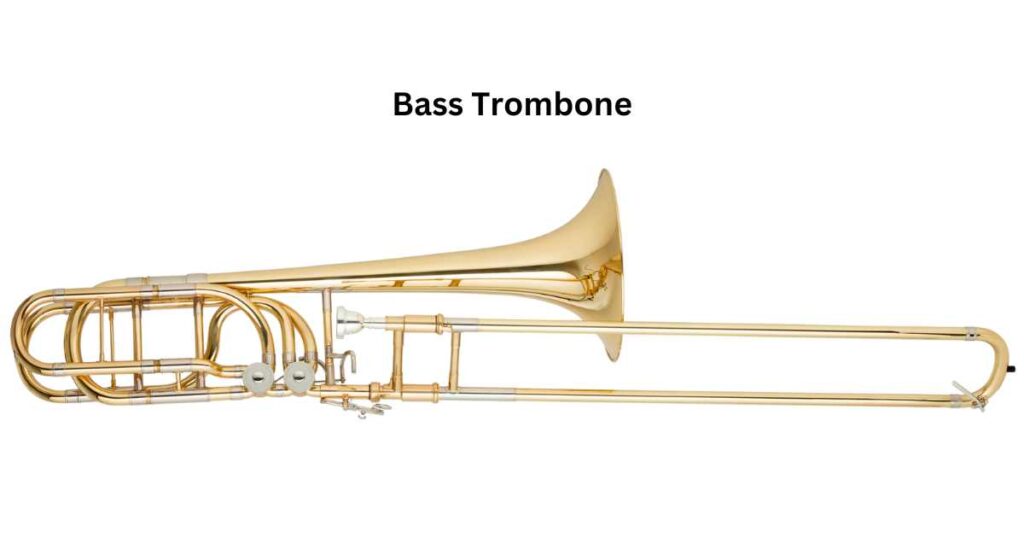
Bass trombones come in two main varieties, single or double rotor. While single valve basses tend to be lighter and cheaper, double rotor models typically weigh more and cost more. Their heavier construction comes with various second valve configurations offering pitch options from Eb down to Db.
Check out this amazing video featuring an experienced Philharmonia bass trombone player showing all of the tenor bass trombone unique sounds:
There are two different kinds of second valves — dependent and independent. Dependent 2nd valves require the 1st valve for playing notes that cannot be played perfectly with just one trigger like low B; independent bass trombones offer better functionality thanks to extra alternate slide positions designed to ease tuning and slide changes.
On an independent valve system, playing open will yield Bb, using one valve triggered gives F and playing both valves together gives Eb while only using 2nd one gives G.
Bass trombones are amazing instruments to add depth and richness to orchestras, jazz ensembles, marching bands and soloists who wish to take advantage of their low range. When used correctly with appropriate instruments and practice sessions — you can produce beautiful tones using this brass horn.
Check out our list of the Hottest Bass Trombones of 2023! These super popular instruments will keep your audience riveted — read on!
Contrabass Trombone
Contrabass trombones are the lowest of their family of trombones – big, bold instruments with low tones that come equipped with larger bells that add resonance to their sound. Some come with double slides that wrap twice around instead of once like tenor trombone – that make their control difficult when performing live!
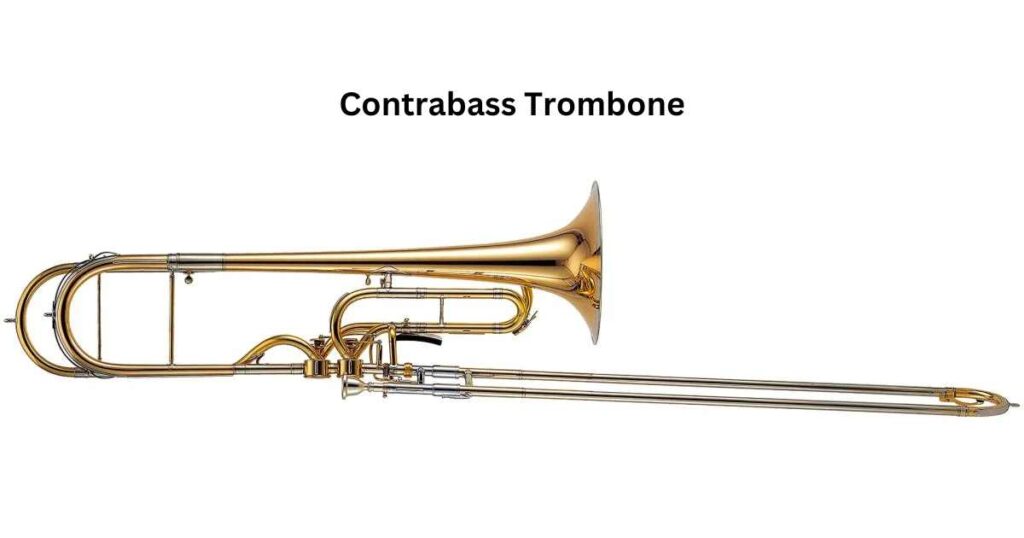
Contrabass trombones sit an octave below their counterpart tenor trombone, often without valves but always sporting a lower range than any other trombone and tend to be tuned F – one perfect fourth lower than the tenor trombone. While historically, B flat or C pitches are also common, most players considered them too challenging and simply did not play them regularly enough.
Here you can watch an example of a contrabass trombone:
This instrument looks just like any standard trombone, only much bigger! At 50 pounds when assembled, its extended slide has only five or six positions — two rotary valves were added in order to play any missing notes.
Professional settings, like orchestras and operas, used to have contrabass trombonists who performed on either bass trombones or even tubas (other brass instruments type) play the contrabass part; today though the contrabass part is almost exclusively played on contrabass trombone, with bass trombonists often handling both roles simultaneously.
Alto Trombone
Alto trombones are one of the more frequently-used smaller trombones. First used during the 16th to 18th Century as the highest horn in a brass section. Modern alto trombone has gained in popularity because it’s shorter and lighter than standard tenor trombones making learning it easier for younger children – plus composers often admire their tone!
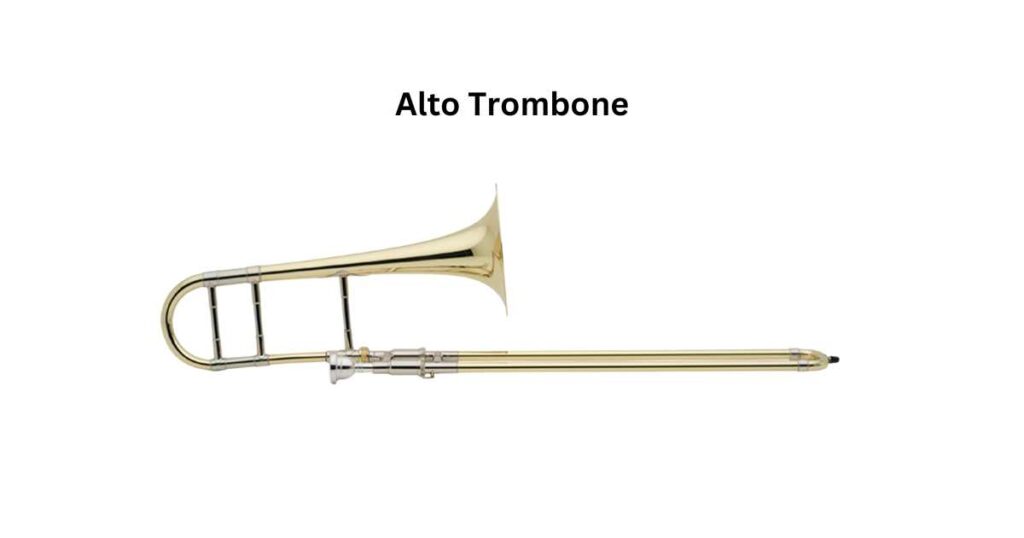
The tenor trombone is pitched higher than most trombones. Yet still cover most of the range found on an alto trombone. Alto trombones feature even higher notes in music composition; unfortunately though, altos can become difficult to come by. Tenor trombones provide an alternative and cover those high notes in musical arrangements explicitly made for them!
Check out this amazing demonstration by SWR Symphony Orchestra’s principal alto trombone player of a professional alto trombone:
Alto trombones typically exist in keys of Eb or F; some models feature rotary valve attachments to alter this to Bb or D for added versatility. Their tone quality tends to sound one fifth higher (in Eb), or about four or five notes higher, than the tenor trombone.
Playing pedal notes on an alto trombone can be tricky due to its smaller instrument. Surprisingly, high notes don’t tend to come any easier on this instrument than on the larger horns; some alto trombone models even feature an additional transposition valve to transpose down from Bb to Eb!
Soprano Trombone
Soprano trombone is one of the smallest and highest-pitched members of the trombone family, boasting a tiny brass bell and bore for higher pitch range. They typically come with Bb tuning – these instruments were traditionally designed for accompanying opera singers during performances.
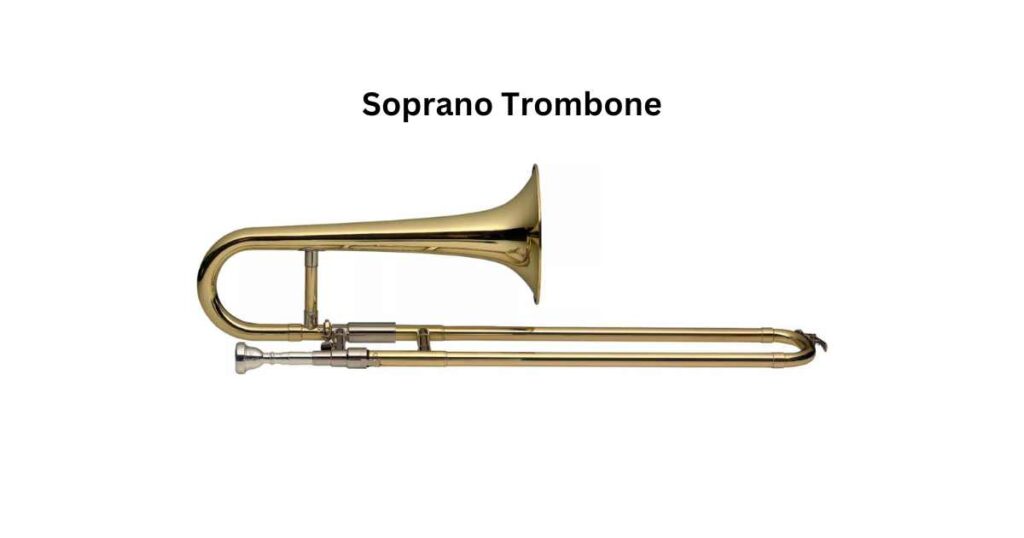
The soprano trombone shares an approximate range with the B flat trumpet, making it useful as an alternate instrument in the trombone section. Due to limited usage in modern orchestral settings and its small slide (hard to tune due to small slide positions) – the soprano trombone is sometimes known as either “slide trumpet” or cornet.
Check out this incredible YouTube demo showcasing a soprano trombone:
Sopranino Trombone and Piccolo Trombone (Pocket Trombones)
Sopranino and piccolo trombones are even smaller and rarer compared to soprano trombones. Their pitches are Eb and Bb – one octave above alto/soprano trombones; two octaves above tenor trombones. Primarily used for jazz performances, often performed by trumpeters rather than trombonists. High, shrill notes produced with small slides make playing very challenging indeed!
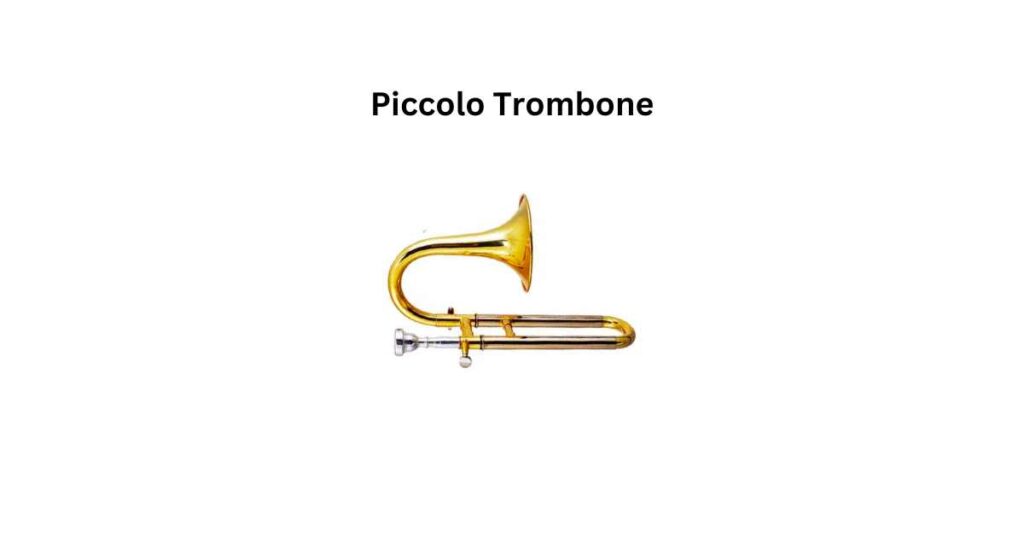
A piccolo trombone may seem small in the trombone family, but it still delivers high-pitched notes! At just a quarter the size of its straight tenor counterpart, these rare instruments feature bores about 1/2 an inch long with four-inch bell diameter bells — very cool indeed!
Demonstration of a Piccolo Trombone:
Superbone
The superbone is an innovative member of the trombone family that blends features from both slide trombones and valve trombones into an effective yet comfortable instrument, tuned to B flat, featuring a wide tonal range, easy switching between brass instruments and three valves before its slide for effortless weight support on either hand and slide release with your right arm.

Maynard Ferguson developed the Superbone trombone during the 70s as an innovative musical experience that combined a slide mechanism with three valves, offering unique playing characteristics for any music style imaginable — jazz, classical or contemporary alike! Trombonists in all these genres quickly took to it – showing its incredible adaptability in playing music of every kind.
Superbones may look complex, but they’re actually surprisingly affordable. Their complex mechanism system mimics instruments like French horn, euphonium or baritone saxophone with impressive results for performances with multiple note ranges for incredible performances.
Cimbasso – Contrabass Trombone With Valves
The cimbasso is an intriguing low brass instrument that blends elements from both trombone and tuba, lending itself well to 19th century opera by composers Verdi, Puccini and Bellini, as well as movie soundtracks today.
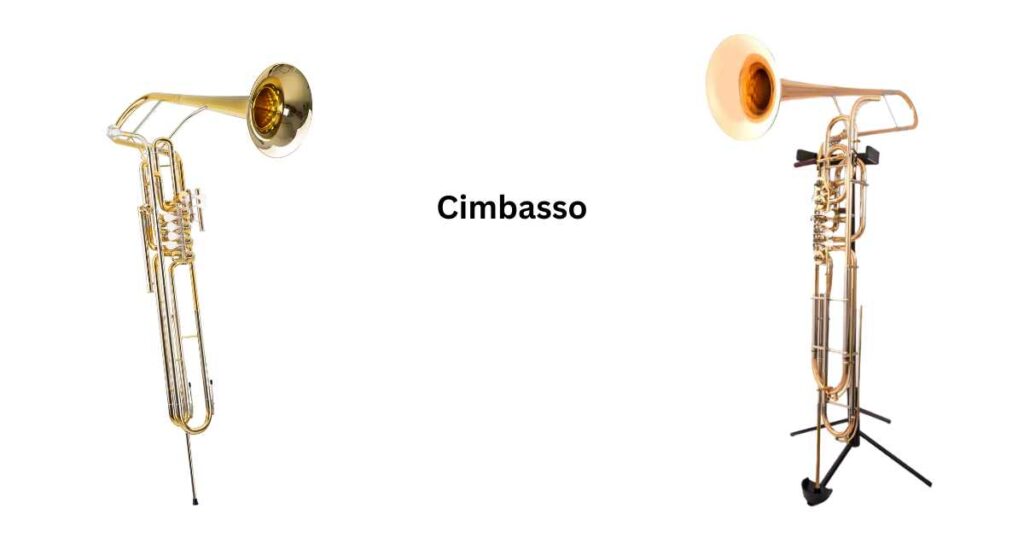
Back then, cimbassos were mainly composed of wood with brass bells for sound production and had narrow bores. Today they feature all brass components while remaining upright – however, these modern instruments come at quite the hefty cost!
The Cimbasso features an intriguing design featuring its bell and valves facing forward for a strong yet focused sound, perfectly complementing the orchestra’s lower brass section. Generally tuned to F, however you might also find them tuned C or E flat depending on the model; its bell measures 11-12 inches across.
Cimbasso trombones resemble contrabass trombones but feature valves instead of a slide for playing music. Similar to a tuba but without a conical bore shape. Easier to play than its contrabass counterpart but still produces rich tones! Sounds very much like its trombone cousin so fits right in with any trombone section!
Buccin: Historical Trombone With a Dragon Head
As opposed to having a standard bell section, buccins featured an exciting curving tube adorned with bright serpent or dragon heads, making for an exciting sound when played loud in the lower register. Today there are more than 60 buccins scattered among museums throughout North America and Europe – these instruments were extremely popular during France’s early 19th century musical culture, like when Hector Berlioz included a part for them into one of his pieces – it could often be heard being played quite loud in the lower register.
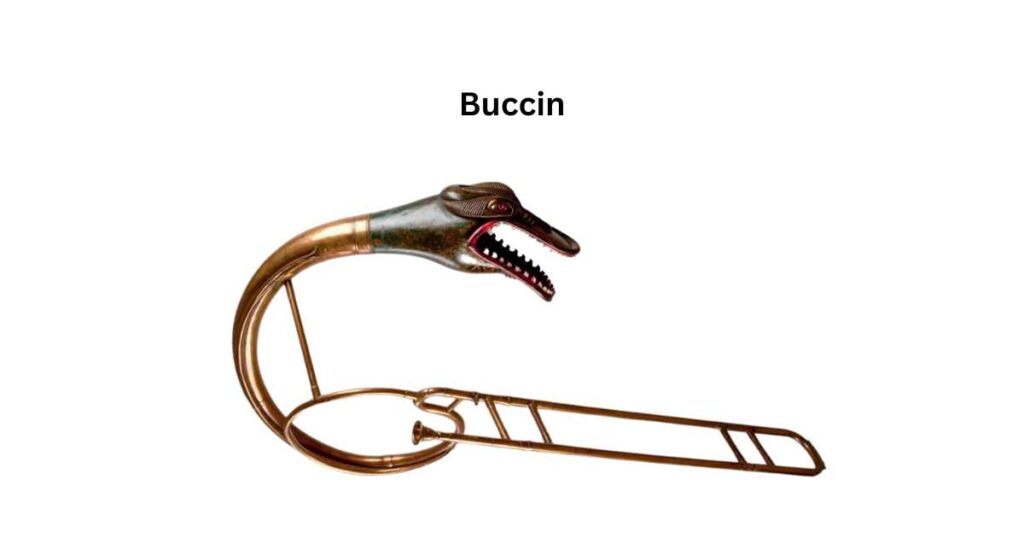
The buccin is an interesting brass instrument that blends trombone and French horn elements into one unique sound source. When played softly, its hammered tin or thin brass bell produces a warm and delicate tone – unlike regular tenor trombones, it offers seven positions giving more versatility; its tone may seem duller, harsher and dryer compared to that of its counterpart, though many military bands were more interested in its visual appearance rather than sound quality.
Sackbut: The First Trombone
A sackbut is becoming an increasingly rare sight these days and is typically custom ordered directly from its manufacturer. You will mostly encounter it live performances of baroque or medieval chamber music performances. Back in the Renaissance days, this early form of the trombone had more delicate sounds but retained a similar sliding mechanism like those we use now.
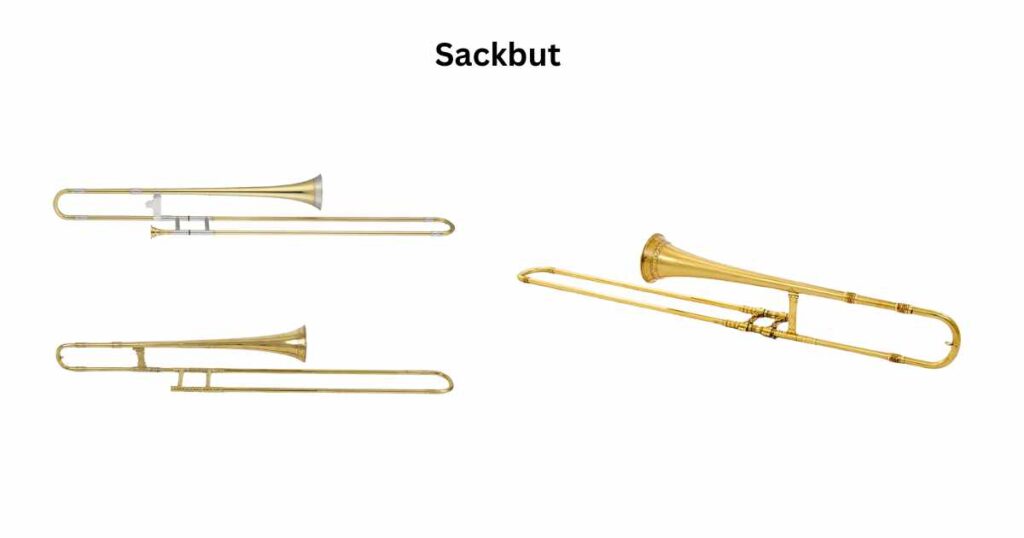
The sackbut became popular in choral and religious compositions during the early 15th century, eventually even making an appearance in opera by 1800! Its name comes from a Middle French word meaning “pull, push”, as playing this instrument requires both pushing inwards while pulling back out, as is done when sliding along its slide. Sometimes bell sections do not require bracing nor tuning slides for optimal sound resonance allowing its sound to resonate more freely with more freedom than ever.
The sackbut, like modern tenor trombones, featured a smaller bell and slide that could extend. It had a less-than-flared bell for quieter playing while typically tuning to B flat. In comparison with modern trombones, the sackbut had limited range due to its smaller bore size producing brighter (more vocal) sounding notes.
Which Trombone is The Best for Beginners?
Finding a trombone suitable for beginning players can be tricky; no single model suits everyone equally well. Every type has a distinct sound and style which might resonate differently with players — often, however, the tenor trombone is recommended as the starter choice.
The tenor trombone is an extremely flexible instrument featuring a wide variety of tones suitable for every genre of music. Plus, its lightweight build and open sound contribute to top-of-the-line tone quality!
A tenor trombone is an extremely cost effective choice, perfect for beginners on a tight budget. Its range and sound make it great for marching bands or performance groups! The tenor trombone is an excellent first instrument choice, thanks to its versatile sound, low price point, and portability — ideal for budding musicians just starting out!
Before diving in and starting to play the trombone, make sure you research different models first. Our post about Tenor Trombones provides more details you need on their parts, range and popular models available now in 2023 – give it a read now!
Range of Tenor and Bass Trombones
Most trombone players can easily hit pedal tone at loud dynamic levels — E on bass clef should represent its lowest note.

Playing the trombone can be challenging (not just in terms of pitch). It’s about how far your slide moves. Finding alternate slide positions becomes easier as notes come closer and the harmonic series gets higher! That is the magic behind playing this instrument — the higher it goes, the more alternate slide positions become available to explore!
As 7th positions often have multiple alternate positions, playing them all effectively can become somewhat cumbersome. To ease this situation, some tenor trombones come equipped with an F Attachment for playing E and B notes elsewhere when valves are depressed — effectively removing any need for having separate 7th positions on a tenor trombone.

The bass trombone shares its range with the tenor trombone but extends even lower. Equipped with two valves – F Attachment for seventh position issues and G flat Attachment to cover between low E and pedal Bb notes. A larger bore and mouthpiece help to play low notes more clearly and precisely than ever. Don’t be alarmed if pedal tones occur occasionally – any accomplished bass trombone player should have no trouble dealing with these low notes!
Are you just getting into learning to play the trombone? Check out Yamaha website, one of the premier manufacturers worldwide, for this useful guide on trombone playing!
What are the most crucial trombone parts?
A trombone comprises many parts, yet some pieces are absolutely necessary to playable performance – these being its bell, slide and mouthpiece.

Bell section
The bell section acts as a resonating chamber, amplifying and projecting sound produced by the slide. To achieve resonance, it consists of several parts including its bell flair, throat, and tube – all work in concert to produce this effect.
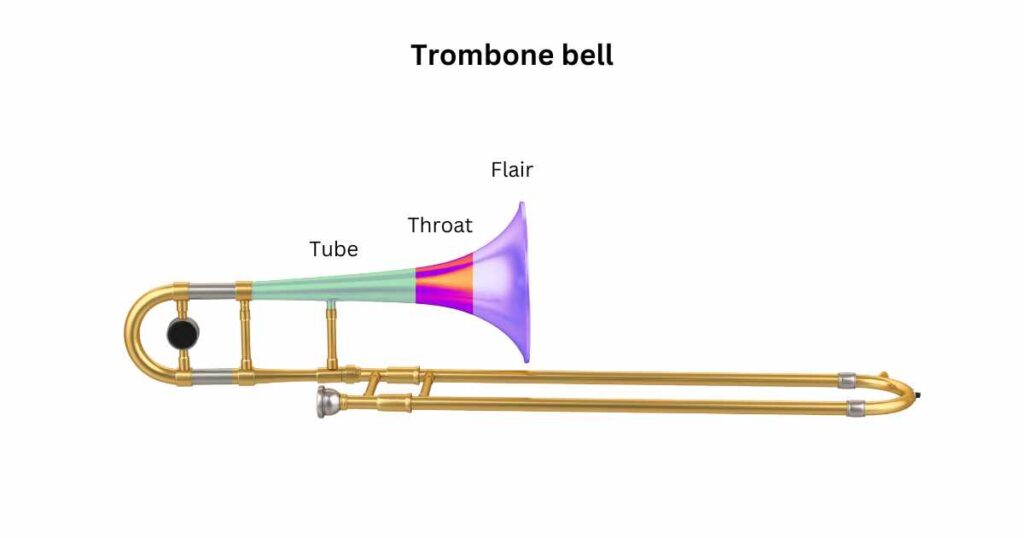
The bell flair is one of the signature elements of any bell section, acting as an eye-catcher that gradually flares out until reaching around 7-9 inches wide at its widest point. Below it lies its counterpart – throat – which helps increase air pressure within an instrument to help project sound effectively.
Slide
The slide section comprises three components, the inner and outer slides as well as braces. Both inner and outer slides can be connected telescopic-ally using hinges — with inner sliding fitting inside the outer slide for smooth operation and length adjustments. Both pieces should also be lubricated to ensure seamless interactions among them all.
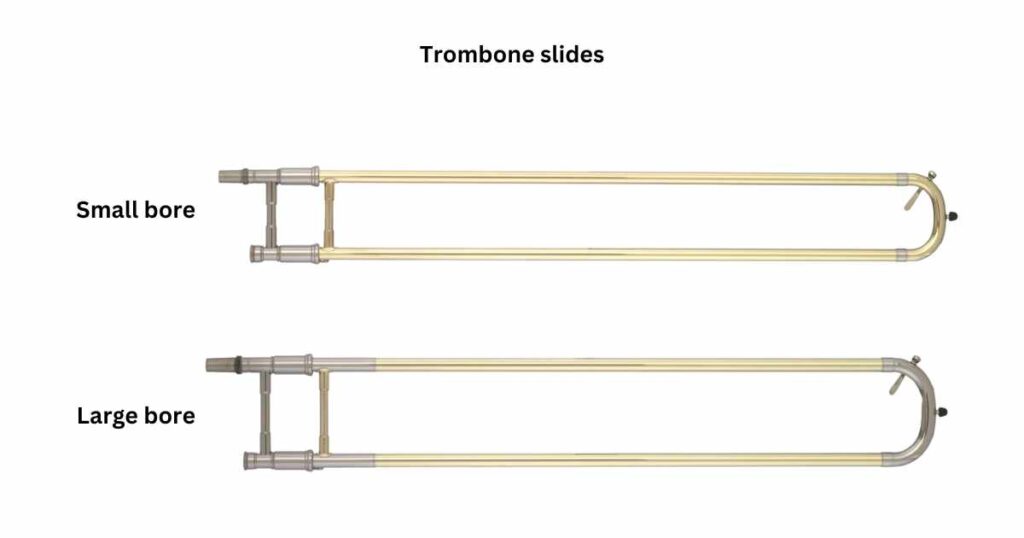
A slide brace (commonly referred to as “strut”) connects the inner and outer slides on a trombone for smooth extension/contraction movement. This adds stability, strength and balance during playback for quicker slide movements with greater comfort.
Tuning slide is another key component of trombones that enables players to adjust the pitch of their instrument.
Mouthpiece
A mouthpiece acts much like the small end of a trombone in that air enters to produce sound, using metal cups, rims and shanks that fit tightly to prevent air leaking out from them.
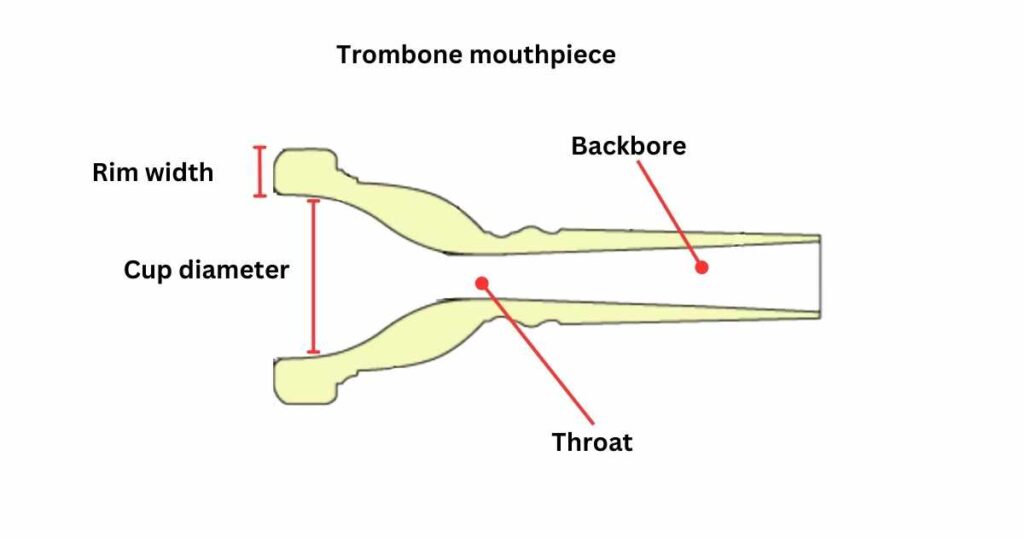
The size and shape of mouthpieces have an effect on how much air can be drawn in through. It produces loud or soft sounds depending on their playing style. For a bright sound in the higher register – opt for smaller models; for darker, deeper tones – go with larger mouthpieces in lower register.
Conclusion
As previously discussed, different types of trombones come in all forms and sizes – perfect for every style of music! From soprano trombones to large contrabass ones — each offers its own special sound and range of tones; you could easily integrate any into a classical, jazz or trombone choirs! Plus don’t overlook more unique options! Exploring less frequently used or quirky ones may open up a whole new world of musical opportunities! So go on, take the leap, experiment – who knows – maybe your new favorite instrument awaits!

